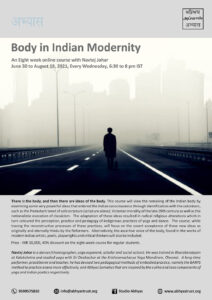There is the body, and then there are ideas of the body. This course will view the remaking of the Indian body by examining some powerful ideas that entered the Indian consciousness through identification with the colonisers, such as the Protestant tenet of sola scriptura (scripture alone) as well as Victorian morality of the late 19th century that led to the forging of a new Indian identity, and thereby a new Indian body. The adaptation of these ideas resulted in radical religious alterations and reforms which in turn coloured the perception, practice and pedagogy of indigenous practices of yoga and dance, as well as the idea of being an ideal Hindu man and woman. To conclude, we will look at the popularity and impact of calendar art as well as the images created by Raja Ravi Varma which virtually entered every middle-class Indian home. While tracing the influences and new-imaginings of being “truly” Indian, the course will focus on the covert acceptance and evocation of some acquired colonial ideas as originally and eternally Hindu by the Reformers.
Price – INR 10,000
40% discount on the eight-week course for regular students.
FAQs –
- Date & Time – An Eight-Week Online Course by Navtej Johar
July 28th – Sept 15, every Wednesday from 6.30 pm – 8 pm - This is a certificate course, and participants can avail the certificate only after successfully completing the course and submitting a written assignment in the form of – a short essay, or an academic paper.
- The sessions will be offered via Zoom.
- Sessions will also be recorded and accessible only for the following one week till the next session. This is for the benefit of those who are unable to attend the live session on particular days.
- Participants will have to sign a form which will confirm that no private recordings and sharing of any material related to the class will be done under any circumstances.
- The course, not strictly academic, will require reading, approx. 20 – 30 pages per week. Each session will begin with a recap of these readings. The reading list is subject to change depending upon the direction our conversations will take.
Select chapters from the following books will be read, referred and discussed during the eight weeks of the course –
- Free Will, Agency, and Selfhood in Indian Philosophy, edited by Matthew R Dasti and Edwin F. Bryant
- The Protestant Ethics and the Spirit of Capitalism, Max Weber
- Many Threads of Hinduism, selected essays, Bankim Chandra Chattopadhyaya
- Modernity in Indian Social Theory, A. Raghuramaraju
- The Nation and its Fragments, Partha Chatterjee
- Colonisation and Culture, edited by Nicholas B. Dirks
- Identity & Violence, The Illusion of Destiny, Amartya Sen
- The Argumentative Indian, Writings on Indian Culture, History and Identity, Amartya Sen
- The Idea of India, Sunil Khilnani
- Against the Madness of Manu, selected and introduced by Sharmila Rege
- Geeta Press and the Making of Hindu India, Akshaya Mukul
- Hindu Mahasabha in Colonial North India 1915-1930, constructing nation and history, Prabhu Bapu
- Theosophy and Yoga, Jenny Baker and Annie Besant
- India’s Kathak dance in historical perspective, Margaret Walker
- Gods in the Bazaar, the economics of Indian calendar art, Kajri Jain
- Photos of the Gods, The printed Image and Political Struggle in India, Christopher Pinney
- Pages of a Mind: Raja Ravi Varma, Life and Expressions, edited by Vaishnavi Ramanathan
- The True Believer, Eric Hoffer
- COURSE MODULE –
- Module 1 – 4 weeks, Body in Indian classical dance & yoga
Historically, the physical body and the idea of the body in both Indian classical dance and yoga have undergone tremendous change. With the incorporation of protestant ideas of moral purity, desexualizing the form, imposition of text over the body, and later with a focus on the correctness of the form while completely absenting the sensitivity of the body, the embodied practices of dance and yoga have transformed in the last 200 years. This section will focus on these changes in the practices and what remains of them today.
- Module 2 – 4 weeks, Body in Modern Indian Art
While the idea of the body in the embodied practices were going through numerous changes and becoming desexualized, pure & pious practices; devoid of any lived histories, at the same time the idea of the body and its representation in modern Indian art was taking a completely different turn. The work of artists and writers like, Amrita Sher-Gil, Francis Newton Souza, and playwright Vijay Tendulkar, and many others were reclaiming the body and allowing it to assert and speak for itself. This module will study these artists and their work closely.

